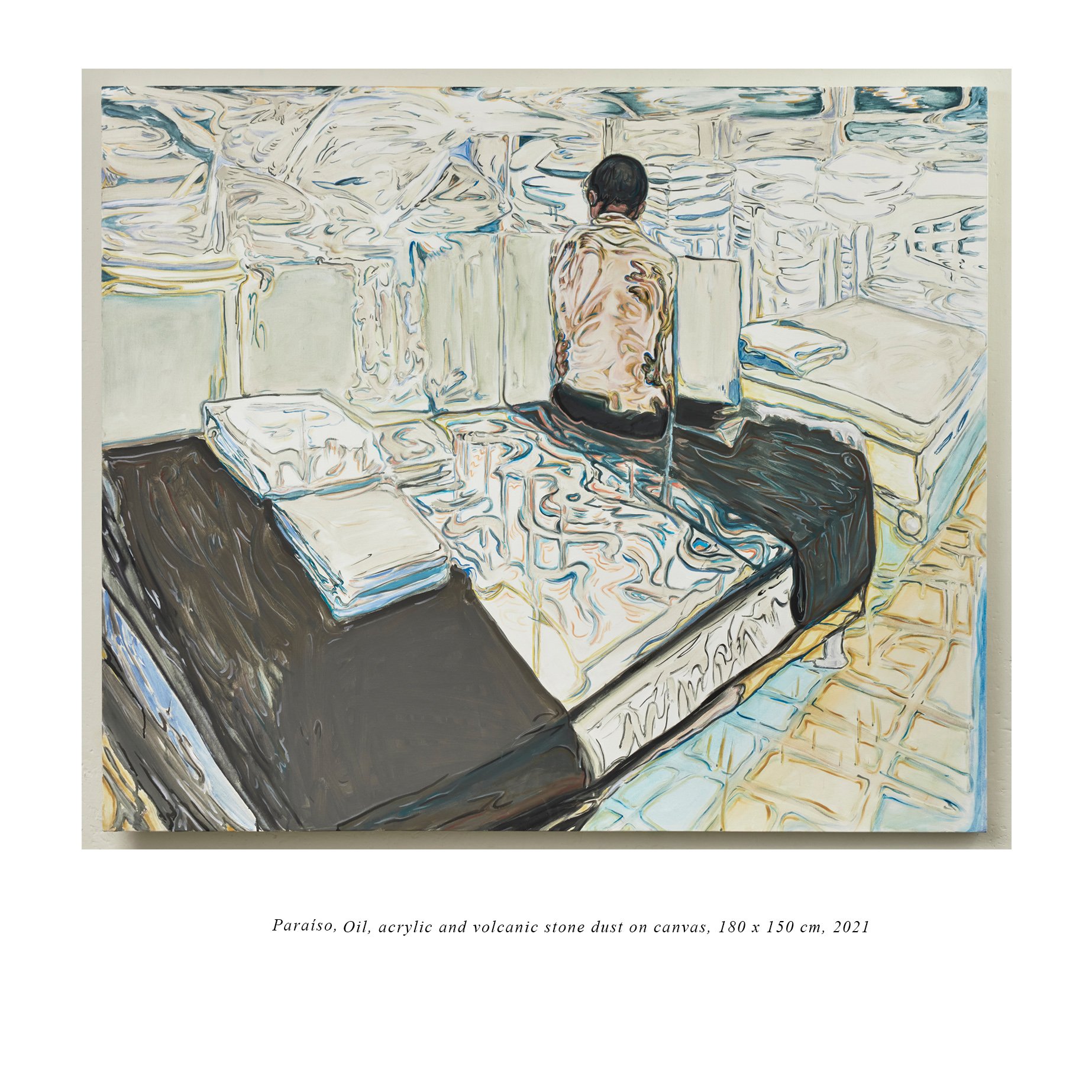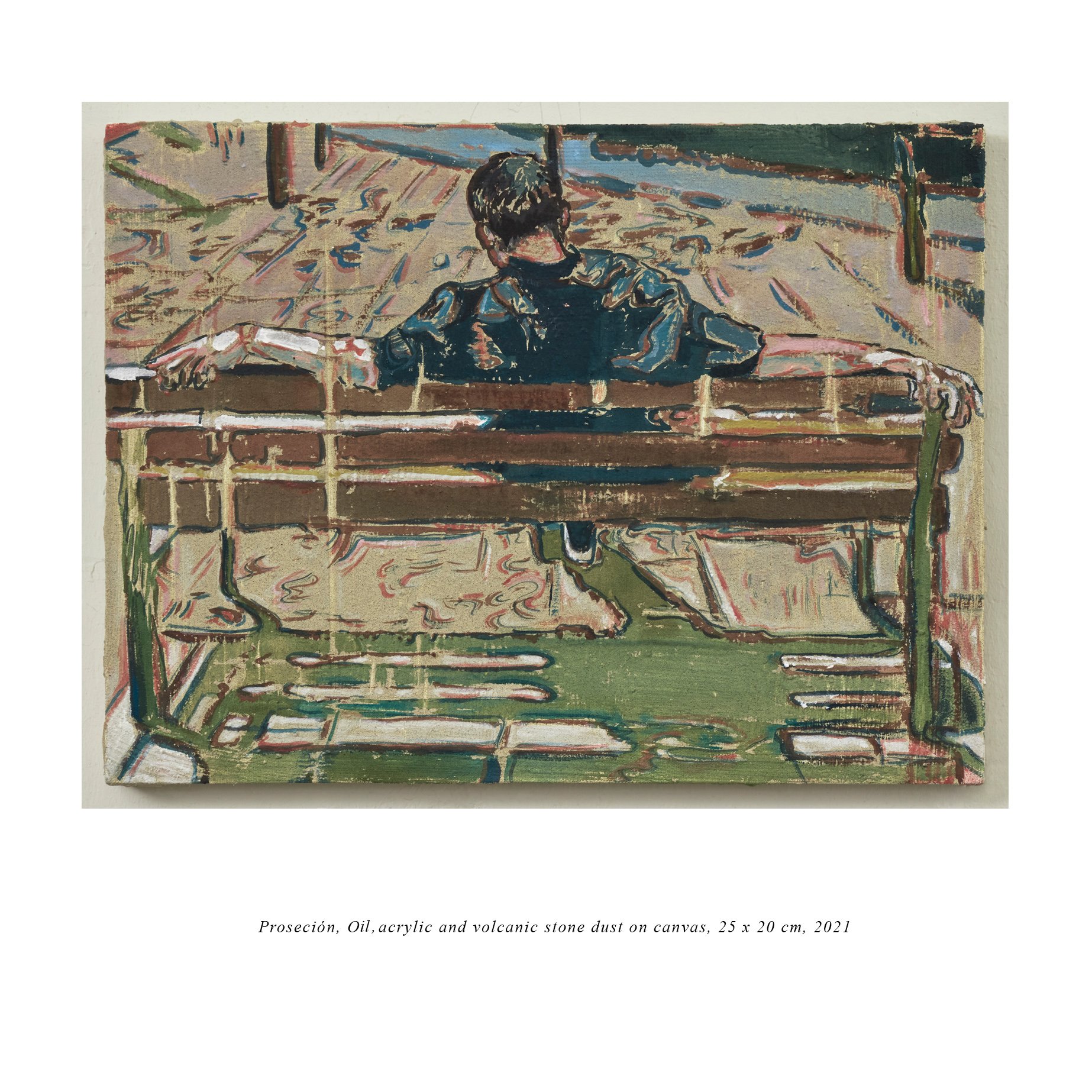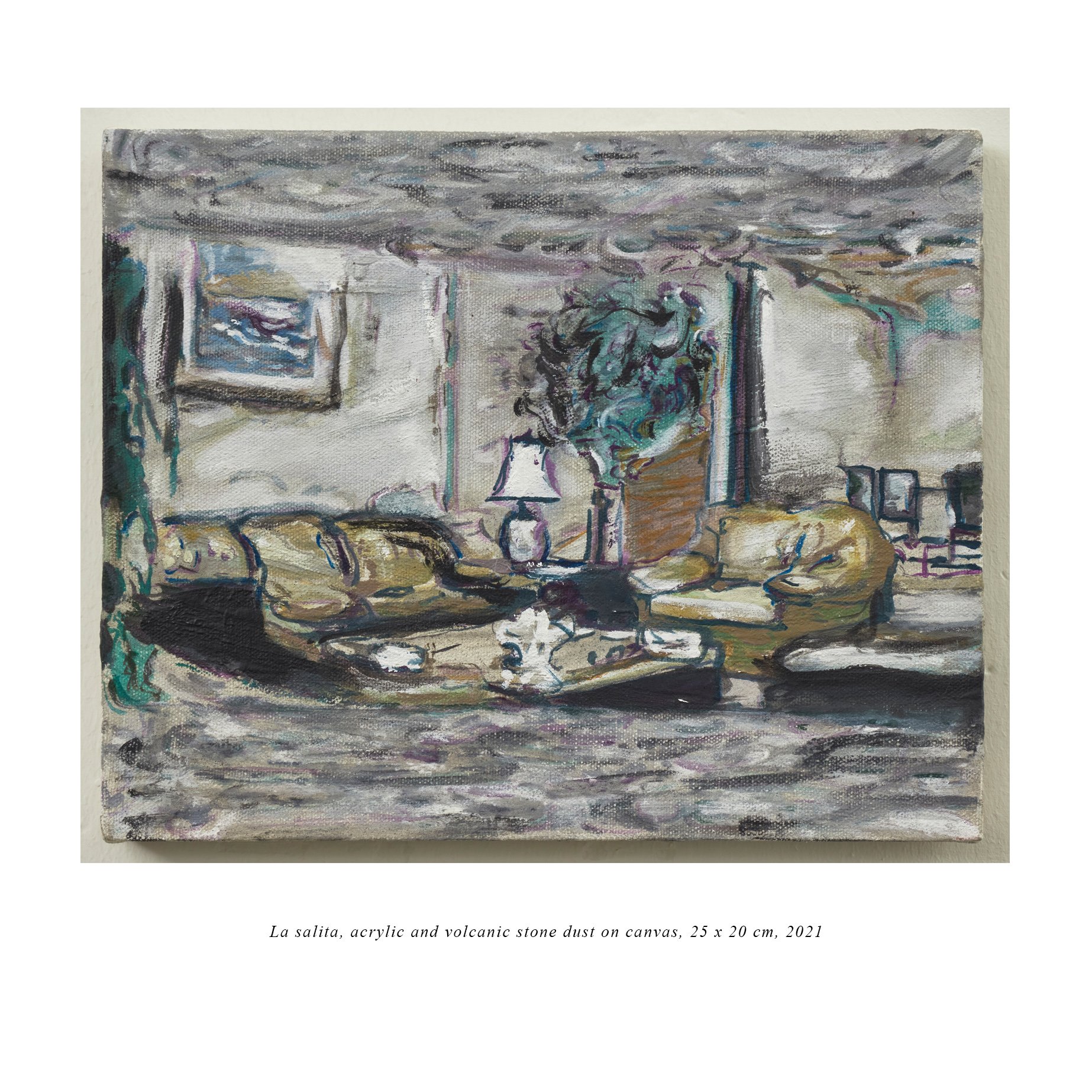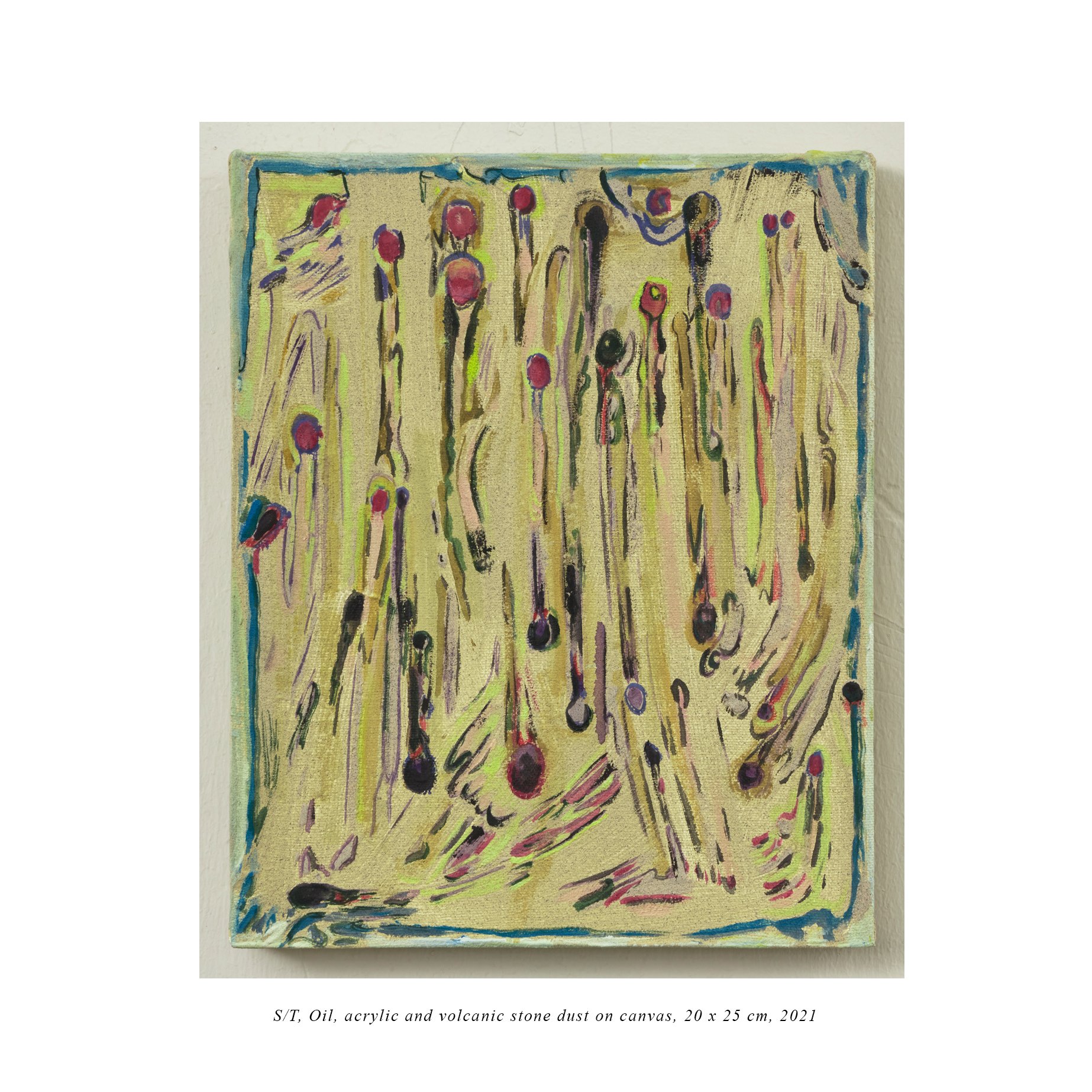Issue # 33 Sebastián Cabrera Arbaiza
Curated by F. Tibiezas Dager

















Remains of Functionality
swimming,
the sensation of
being dirty in
body and mind
summer as a
time to do
nothing and make
no money.
- Eileen Myles. Peanut Butter.
In Sebastian Cabrera´s recent pictorial work there is evidence of an interest in portraying productivity centers. In which the adult life of an eternally aspiring social class transpires. Scenarios where the management of functions are disrupted by the passage of time or the economic collapse are presented. These paintings belonging to the series " Fixed ideas, loose walls " (2020) and " The dead ones pocket " (2021, ongoing) which serves as approximations to what happens at the borders of the corporate landscape and its demands for reinvention and self improvement in between constant crisis.
Based on the contradiction of wanting to expand the work space while preserving the idea of collective well-being, these pieces appear as reinterpretations of the ways in which labor mutates. Unleashing images which depict a dystopian labyrinth from the statements of organizational psychology, internal regulations and the goals set up to be fulfilled.
The worker is a faceless subject, with all his faculties in place, its figure emerges every time. Becoming a chess pawn, suspended between the foreseen ruins made up of the elements that surrounds them. The architectures on these paintings sweat, smoke and melt . Turning the hyperactive building into a sick inhabited organism. The factory was already demolished and invisible due to the distancing that current societies maintain towards misanthropic structures. The leading return of human labor is not due to a revaluation of technique or the trained eye, but for its "sentient" quality within an economic landscape influenced by the politics of empathy and the compulsion to resolve differences through the dissolution of the other. The worker, unlike the machine, cultivates ideals and yearns for recognition. It is due to these efforts that productivity is consolidated not as a goal but as a signifier. The employee is defined by his ability to use his work tools and how he expands through them and vice versa. The relationship with the objects and the developments within the vectors define who one can become.
Who once was a worker finds liquidity in the face of credit and extends the accumulative capacity and access through loans. It acquires relevance and becomes a partner through individual assessment of workplace malaise. Accepting irregularities and constant delays, paying the price of starting from the bottom. Inside the dead ones Pocket, corporate beings become aware of how their existence depends on being immersed as part of the "dynamics". An in-betweenness that exhausts, but defines them. They become pieces within the endless tasks that do not cease. Carriers of a psyche with which the board can always count on to negotiate.
In Clausura (2021), existence within everyday work results in self - perceived insignificance, induced by the everyday workplace routine. A glistening-edged drain takes over. It´s not water that enables a multidirectional flow but the flood that disappears everyone involved and flushes down the documents in which reality is attested. Paraíso (2021) Is a voyeuristic visit with inversed deserted sensations of a department store. In the aforementioned pieces, the slow but distinguishable catastrophic approach does not recognize divisions between the imaginary and the real. The calamity and its potential to eradicate seems to touch everything that seems valuable for the enterprise. It transforms everything in its path. Making the crisis a simulacrum in which itineraries are reconfigured and re-thought of to potentiate the strengths that surrounds scarcity.
In the midst of growing cracking holes, facades seem discolored but the epicenter will show reports based on recorded effects. What is perceived as precarious will generate progress demands and innovation desire to consolidate the need for change.
The employee who is disfigured by the accident (Huayco, 2021) and the unemployed character who turns his back on us (Procesión, 2020) are not the living dead. For the employer-godfather-panopticon there is a radical distinction between what a living person achieves and what a dead person can do. The deceased, considered within a social security plan, ceases to be a burden to society and becomes a corpse. His decay is not compostable and the body needs to be taken as soon as possible. The zombie figure falls short from the employee´s reality who finds himself dying by the minute while working. Keeping up with it´s appointments and clients while tumors spread within.
In Cemetery (2020) the rows of monitors imitate a pantheon which serve as obituaries of the working class and the identity of who they once were. People are discarded, but the simple machinery remains in place, dozing off in their absence. This view looks like an underwater dump. Where the scrap seems to have been relocated at the bottom of the sea. While focused on the inanimate object it seems that contemporary suffering is suppressed, but at a second glance there is an unveiling that can be identified by how these objects were placed. Revealing a function that can only be executed by the one who is no longer present. When a tool is assumed as a ruin it starts occupying a passive posture. Reproducing nowness that collapsed in the face of possible "leisure" reality being they are already useless.
The horizons of dispossession contain a graphic description on the demise of ideals. In the portrayal of ruins, the author 's affective predilections around deteriorated places are evident. A question on relevance comes into play as it is highlighted by the influence of its reverse. One can picture the decadence degree of a location and it´s elitist past based on the rottenness that it now embodies. These abandoned places can be considered as crossroads from where major economies were orchestrated. La Salita (2021) and Salón (2021) refer to business and governmental spaces present in the Limeñan imaginary where the decades long Fujimorism dictatorial regime was choreographed from. These small paintings enable passageways that lead us to visualize how these rooms would have looked like today. The rottenness of such acts finds a body with passive gestures of the hands that gesticulate in Términos y Condiciones (2020). These are like dead weight bundles that pile up in similar political spheres, but with different ambitions. Landing malicious functional dynamics where corrupt supply and demands are made explicit. Other than using the dehumanizing pig figure to refer to the businessman or an ant for the working class, the human condition is highlighted by how flesh is portrayed as it decomposes in the mid-transaction. But it is outside where waiting occurs that life unfolds.
The exhaustion of being stuck in bureaucratic traffic has the ability to give rise to an agony that shapes the perception of the composition of places. The shadowy figure breaking the fourth wall within Radiography (2021) sits still inside a heavy and cold structure until a ticket, a stamp or a metallic voice enables it. Very close to getting the aspired job, a needed medicine or information if it weren't for the pirouettes and bureaucracy that a ministry bureau requires. The patient becomes a spectrum that runs in circles through a system that postpones and cancels the convalescent.
Painting, and its plasticity, is a privileged media to convey such subjectivities and postures in our current times. The waiting and the ambivalence to which the regulatory economic organs = health structures submit individuals to, conceiving a vision that ends up generating a delusional record that contradicts the pedagogies and the advertising that seeks to control public life. Sebastián Cabrera ́s paintings create a place where a ludic boycott discontinues positivist discourses by inverting the semiotics of production. Serving as an archive of decay in which the ways of portraying contemporary neoliberal architectures aimed for production and order are revisited. Its protagonists, their everyday objects and desires are captured within a panorama in constant collapse, exposing the materiality of which goals are made of.
F. Tibiezas Dager
Sebastián Cabrera Arbaiza
Born in Lima, Perú (1982) Started his bachelor studies in the Pontificy Catholic University of Peru (PUCP) to latter conclude them in the University of Barcelona (UB). He obtained a masters degree in Production and Investigation in visual arts (UB). Currently he lives and works in Lima. He directs the exhibition space known as El Garaje and regularly participates as a consultant in the Colección Cooperativa- CCCP. His solo shows include As Castles (2010) , Stalking the Image (2012) Galería Lucia de la Puente (Lima,Perú), The suspension of disbelief (ArteBA, 2013), Fixed ideas, loose SEBASTIÁN CABRERA ARBAIZAwalls (Crisis Gallery, 2020)

